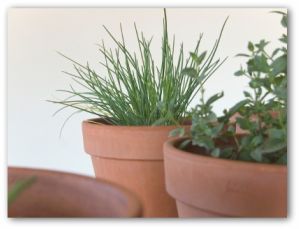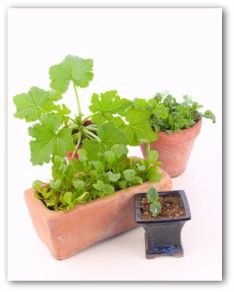Indoor Gardening Tips

Here are a few indoor gardening tips for the beginner who wants to grow a vegetable garden at home.
Learn how to select plants, containers, and the best location for an indoor vegetable garden.
Just because many of us do not have a huge backyard, or live on a farm, doesn't mean that we can't raise our own fresh vegetables at home.
Design Your Own Vegetable Garden Layout Using our Free "Vegetable Garden Planner" Software!
- Even a small potted vegetable garden can provide a good amount of fresh produce and herbs.
- Planting a vegetable garden, no matter how small, can be a very satisfying experience!
- Almost all vegetables can be successfully grown indoors in a container garden.
- One of the many benefits of indoor gardens is being able to protect your plants from pests and diseases.
Download Free Garden Planning Worksheets, Garden Diary, Zone Chart, Or Planting Guide
Another indoor gardening tips is knowing exactly what goes into (or onto) the food you grow.
If you are interested in growing organically, there are many organic seeds, plants, fertilizers, and pesticides available online or at your local garden center.
Many garden centers have a master gardener on their staff who can also provide additional indoor gardening tips.
The first step is to decide where to locate your indoor garden.
Choose a sunny location, as most vegetables require at least six hours of sunlight each day in order to grow and develop properly.
Depending on how much space you have available, choose your containers and decide which vegetables you want to grow.
Be creative; sometimes a shelf in the right spot, or a hanging planter can add some extra planting room to your garden.
Start early--
Make a plan of which vegetables you want to grow before you head to the garden center.
Buy early in the season to find exactly the right plants for your indoor garden needs.
Indoor Gardening Tips for Choosing Plants Wisely--
- A fool-proof tip for indoor container gardening is selecting your plants wisely.
- Pick out a mix of plants in differing shapes, colors, and sizes to create your own garden arrangements.
- Choose your favorite vegetables for your container garden, as with limited space you can't afford to waste any space growing something that is not a favorite.
- When growing from seeds, determine the best garden performers for your area as tested by local gardeners.
- Many vegetable plants can be sown directly from seed, while others may be started as transplants indoors.
- Another indoor gardening tip is to be very careful when handling small seedlings, as their roots are very delicate and easily disturbed.
Check for sunlight requirements of each plant, as you will want to group plants together that have similar needs.
Almost all garden vegetables require a sunny location to thrive.
Lettuce and spinach are two vegetables that will do fine in a lightly shaded location.
Also, find out the plant’s hardiness for cold temperatures when being grown in containers on enclosed patios.

Indoor Gardening Container Tips
Another indoor gardening tips:, bigger is better when it comes to the containers.
Larger pots hold more soil and moisture, and therefore allows the plants to grow a bigger root system.
This allows the plants to grow larger, and to go longer between watering.
There are many types of containers available from recycled, to inexpensive, to very expensive ceramic or glass containers.
Just be sure that all your containers have drainage holes in the bottom.
Place the containers in trays to catch any water that runs through the soil and out the bottom of the container.
Just do not let your pots stand in water continuously, as your plant roots do not like to be water-logged.
Feed indoor plants well. Buy potting soil or make your own with added slow-release fertilizer.
Feeding too much on the other hand, will be a different source of stress for your vegetable plants.
Do not exceed recommended amounts of fertilizer.
Extra fertilizing builds up salt levels around the containers, in the soil, and can burn the plants.
If the air is too dry, your indoor plants could suffer.
Most vegetable plants thrive in high humidity. Add moisture to the air if necessary.
A spray bottle of water can be helpful to keep the foliage of your plants lightly hydrated. Low flat containers are also good for this purpose.
Other tips for indoor gardening include rotating your plants, so that all sides receive sunlight.
To help you remember to do this, give the plants a quick turn every time they are watered.
Even sun loving annuals need a break from the sunshine sometimes, especially in very small containers or hot locations.
Help potted plants thrive by giving them afternoon shade.

- To make the most use of limited indoor space, plants can be pruned, tied, and trained.
- Even large plants will learn to conform. Seedlings and transplants may be started indoors and then moved outside.
- Wintering plants need less attention with water and fertilizer.
- Providing your indoor plants with the right amount of water is a priority for indoor gardening.
- Giving them too much water is as bad as not enough.
- Check to see if the garden needs watering at least once a week.
Indoor gardening watering tips:
- If watering the indoor plants on a schedule poses a problem, purchase self watering pots. The containers are available in a variety of sizes and a rainbow of colors. Once the plant is established, it will automatically drink water when thirsty.
- Growing hydroponics is a fun way to grow vegetables! With easy to use kits and growing lights, you can grow nearly any plant grown outside, indoors.
- Read as much as you can from other gardeners for indoor gardening tips.
- Discover about all the exciting plants there are to grow and innovative ways to have a great indoor garden!
- Extend gardening fun by bringing your garden indoors.
- Inside container gardens provides shelter from cold and wind and extends the season for growing all year long.
Ask your friends who garden for additional indoor gardening tips.
Most gardeners are more than happy to share knowledge and tips about indoor gardening with others.
Planning and growing an indoor vegetable garden can be a very fun project for the whole family.
Planting vegetable seeds, and watching them grow is interesting or exciting for people of all ages and backgrounds.
An indoor garden can be a colorful and beautiful focal point in any part of your home.
You will enjoy eating the fresh delicious vegetables that you have grown in your own small home vegetable garden.
You might also like to read:

